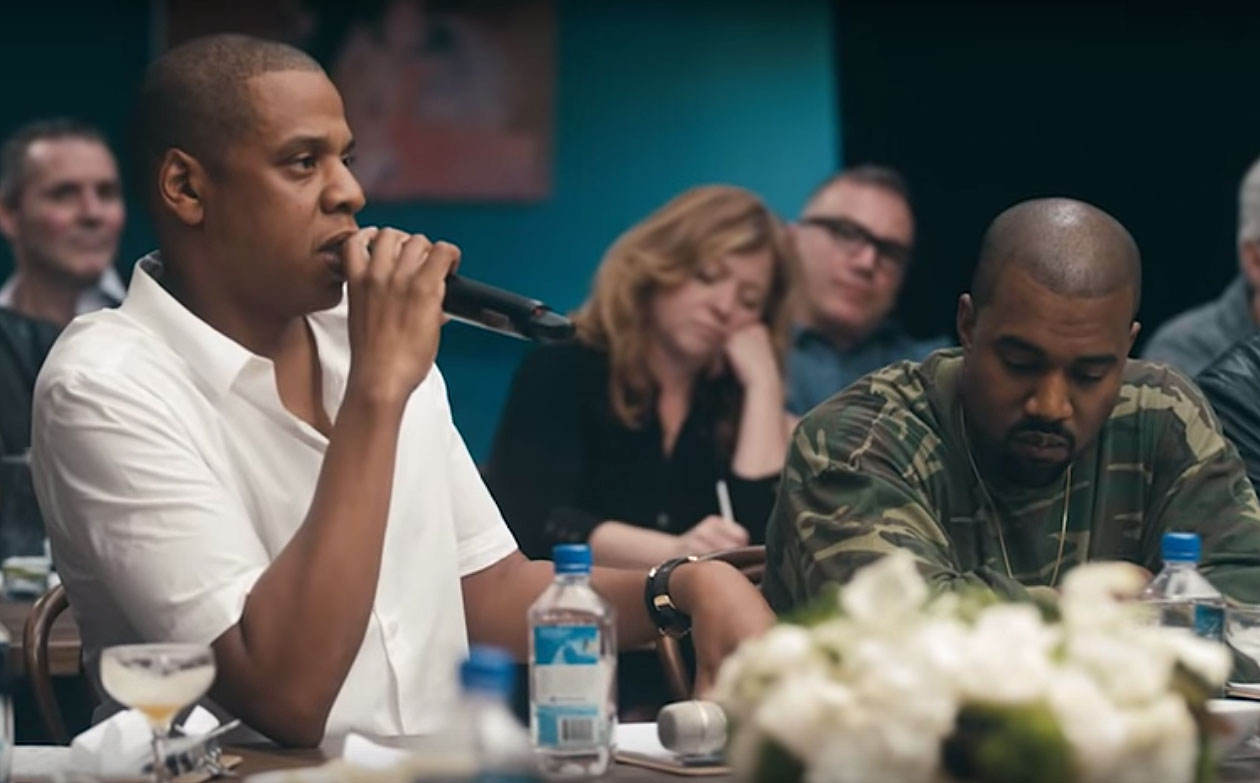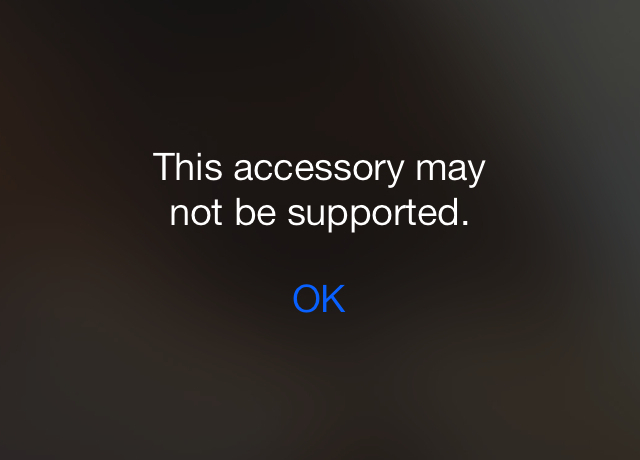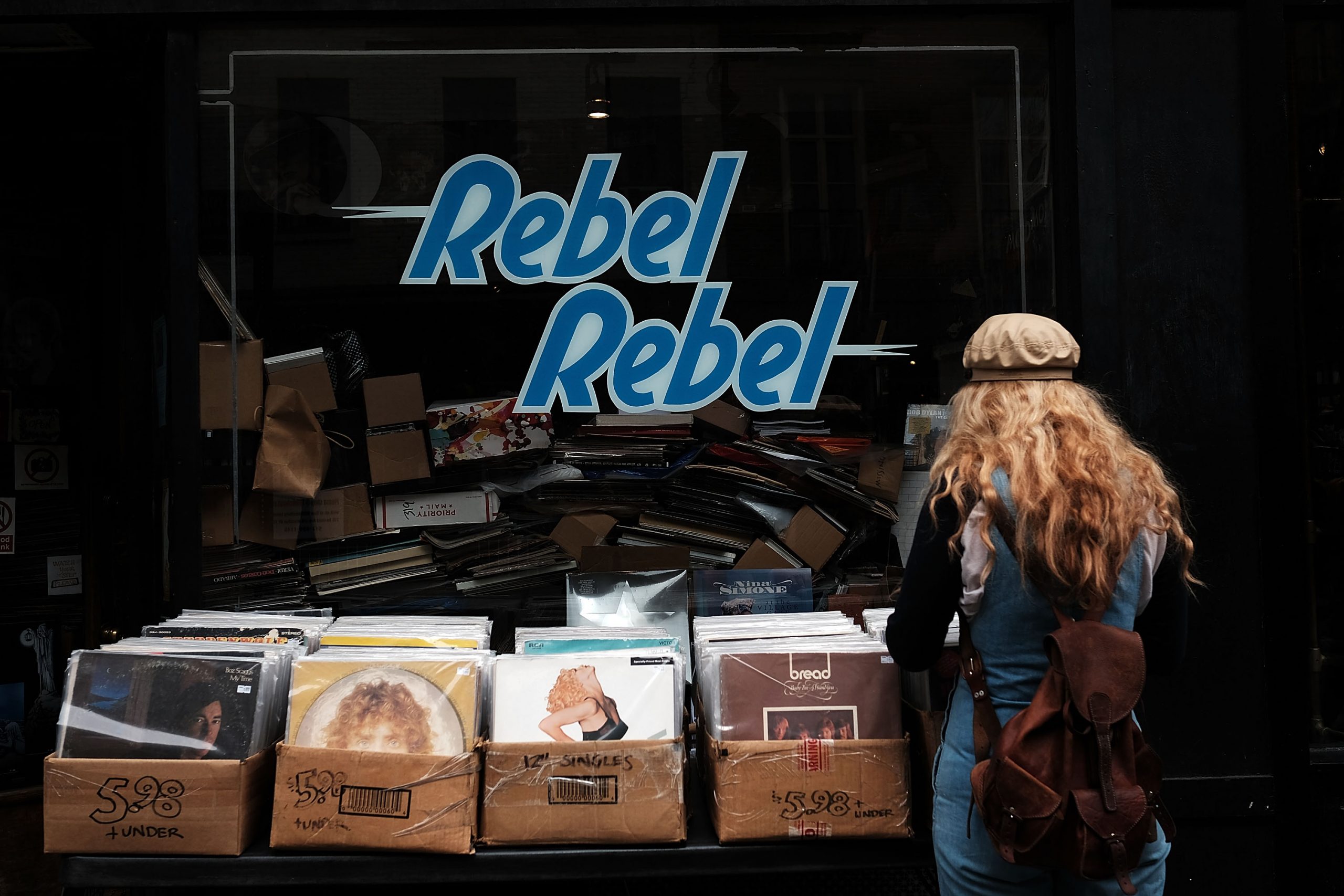There's no point anymore in trying to keep up with the records broken and set by Drake's VIEWS because its legacy further swells every week. Billboard tried to catalog the album's many historic accomplishments a month ago, and today, that list seems laughably outdated. Drake has long since passed the comparatively lightweight likes of Usher, Adele, and Eminem. VIEWS is now on equal footing with freakishly huge hits: the Titanic soundtrack; the Frozen soundtrack; Alanis Morissette's Jagged Little Pill; Santana's Supernatural.
But Drake is not a freak. I mean, he's probably a freak, but his success is not accidental, anomalous, or random. He's a career artist, and he now stands among giants. Look at these actual headlines!
Is that not remarkable? Is there a higher ceiling for him to shatter, or is he now simply left to build and scale his own skyscraper? Drake is inescapable, and in summer '16, the media coverage devoted to VIEWS falls short only of the media coverage devoted to Donald Trump.
That being the case, it is a little ... strange, I think, that we've all failed to properly recognize what is, in fact, the most noteworthy -- the most remarkable -- thing, statistically speaking, about VIEWS' chart dominance and Drake's unprecedented run.
And what exactly is the most remarkable thing about VIEWS?
Great question. First off, here's what is not the most remarkable thing about VIEWS:
The most remarkable thing about VIEWS is not how many people are listening to VIEWS.
(Millions of people are listening to VIEWS. Tens of millions? Probably. Maybe. Let's just say millions for now.)
The most remarkable thing about VIEWS is also not how people are listening to VIEWS.
(Streaming. Only streaming. God love it. Actual sales dropped 70 percent after week one, and then another 53 percent after week two, and then another 39 percent after week three, and they've mercifully sort of maintained a steady 20-percent-ish week-over-week decline since then.)
No, the most remarkable thing about VIEWS ... is where people are listening to VIEWS.
It's important for us to define some terms here, to consider how the on-demand music-streaming market breaks down, at least as it pertains to VIEWS' ownership of the US charts.
Today, in this country, there are really only two on-demand streaming services of any significance: Spotify and Apple Music. YouTube is bigger than both of them, but when we're comparing VIEWS to fucking Purple Rain and Thriller, we're using Nielsen's data and playing by Nielsen's rules, and Nielsen (inexplicably) doesn't count YouTube streams toward its stream-equivalent sales totals, so YouTube is a non-factor here. Then there are little fish -- Tidal, Google Play, Rhapsody-aka-Napster, Deezer -- but for our purposes, they're all negligible. They have almost zero market share and questionable engagement numbers. They don't move the needle.
So we've got two services responsible for something like 95+ percent of the US streaming market. The bigger of the two, by a lot, is Spotify. Spotify has 100 million monthly users including 30 million paid subscribers. On the rung below Spotify, commanding a much smaller slice of the pie, we have Apple Music with 15 million subscribers. Speaking of pie, let's have some!

Make sense so far?
Good. So anyway, Spotify's current record for most streams from a single album in its debut week in the US belongs to Justin Bieber's Purpose. Songs from that album were streamed 77 million times during the week ending 11/19/2015 -- just on Spotify, just in the the US. But when that record was set, it went beyond Spotify: Purpose had the best first-week streaming numbers of any album ever, with roughly 100 million streams across all services in the US. Again, when we're talking about numbers this large, "all services" basically just means Spotify and Apple Music. In any case, this is how that pie looks.
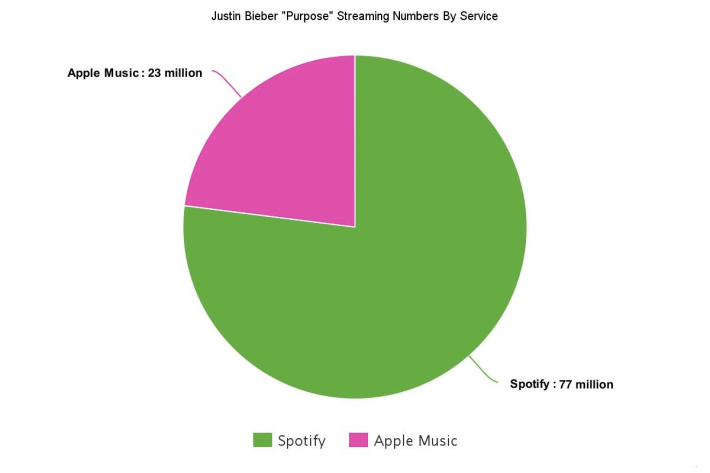
Note the resemblance to Chart 1. More or less what you'd expect, right? Given that data set, that's somewhere within the standard deviation.
OK, moving on. When VIEWS was released, it set a new record: 245.1 million streams in the US alone -- that's vastly better than Bieber's total across all streaming services, and it absolutely squashes the scrubby 77 million that Purpose achieved on Spotify. Look again at the two pie charts above -- remember that Spotify has 100 million users and Apple Music has only 15 million -- and then look at this.
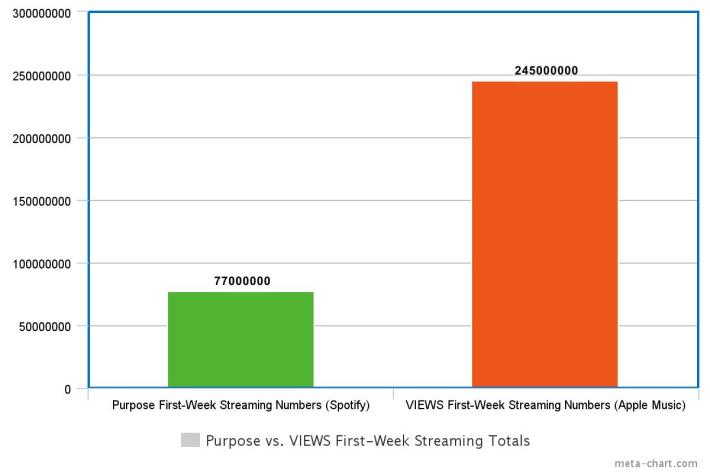
Now that is SOMETHING! You don't see that every day, and if you look at statistics a lot -- especially when dealing with samples sizes this substantial -- you never see that. That's just not how big numbers move. If you work with statistics and you see something like that, your first thought is typically going to be that you've made a mistake. Maybe you entered an incorrect figure into one of the fields. You'd go back and check to make sure.
And once you were sure you hadn't made a mistake, you'd look for an explanation. Maybe it makes sense? Maybe Drake is just a much bigger artist than Bieber, and VIEWS was a much more anticipated album than Purpose?
Maybe. There's probably something to that.
So anyway, for the first two weeks, VIEWS was available only on Apple Music. You know what happened in week one. In week two, VIEWS songs did 140 million streams. (By the by, it is profoundly fucking weird that VIEWS' numbers dropped by 105 million (!) and the thing still did nearly twice as much as Purpose's record-setting week on Spotify, but let's not get into that right now.)
And then, in Week 3 (5/13 - 5/19), VIEWS went wide: to Spotify and everyone else (i.e., to Spotify).
Prior to that point, VIEWS' reach was artificially limited by the very, very small pond in which the album was swimming. Based on the patterns, the markets, and the cultural climate, you might have expected its numbers to explode when it was finally made available to everyone. Think about it: VIEWS did 245.1 million streams in seven days when only 15 million people could listen to it; what would it do in the first week it hit the open market? Three times that many? Four? Could it do a billion?!?
Haha, nah. Wouldn't that have been something! But no. Nope. It couldn't. It didn't. Didn't come close.
It did 186.1 million. Total. Apple Music plus Spotify. Way down from week 1, sorta up from week 2.
WTF?
I found this unusual, so I kept tabs on the story. I did some reporting. I hit up as many people as I could -- I asked anybody I could think of, at every relevant outlet, who might have any insight into this bizarre phenomenon -- but I didn't get much in the way of answers. Still ... I didn't get no answers.
On Friday 7/28, VIEWS had been on Spotify for 11 weeks. Between 5/13 and 7/28, songs from VIEWS had done just about 1.3 billion streams across all services in The US. That number comes from Billboard, and Billboard gets it directly from Nielsen. But Bilboard doesn't tell you where the songs are being streamed; they only tell you how many.
I wanted to know where.
So I called someone at Spotify and asked: Since the addition of VIEWS to your library, from 5/13 - 7/28, how many times had songs from the album been streamed on Spotify in the US?
This is the answer I got: 645 million.
Impressive number. Big number. Drake is a star. Seriously, that's a very healthy number of streams.
But 1.3 billion? That is a much bigger number still.
Somehow this market:

Had produced ... THIS result:
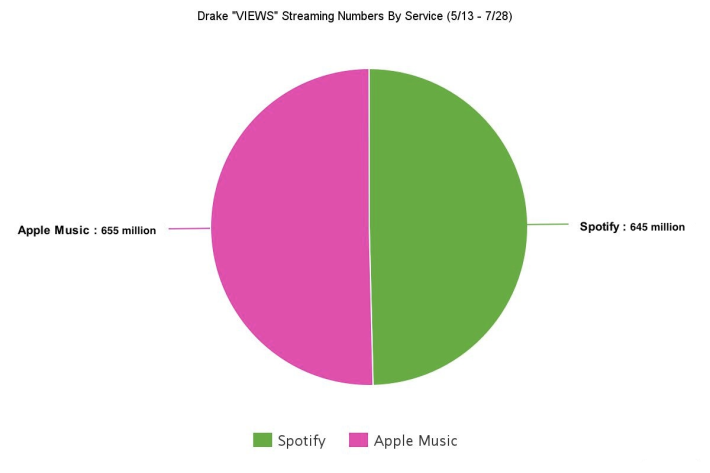
That's what I mean when I say that where -- not how, not how many, but where -- is the most remarkable thing about VIEWS. Tiny little scrappy insurgent indie-sized Apple Music was absolutely demolishing monolithic gargantuan world-eating industry behemoth Spotify.
So ... how?
I came up with seven possibilities. And they are:
1. The numbers quoted to me by my contact at Spotify were inaccurate.
2. Spotify is straight-up lying about the numbers to me and everyone else.
3. Spotify users just don't really rock with Drake.
4. Somebody is using bots to juke Drake's numbers on Apple Music.
5. I'm failing to account for some significant variable or another. For instance, Tidal.
6. Apple Music is lying about the numbers.
7. Apple Music has corralled almost 100 percent of Drake's core listener base and they are all obsessive stans.
Let's line 'em up and knock 'em down. Starting from the top:
1. The numbers quoted to me by my contact at Spotify were inaccurate?
This seems like it could be a possibility, right? People make mistakes. Maybe my contact had made a mistake?
Could be. But I don't think so. Here's why:
Those numbers add up. If VIEWS had done 645 million streams over 77 days, it would mean an average of nearly 8.4 million streams per day. Even for Spotify, that's a lot.
Consider this, for context: In Purpose's record-setting first week, the album did 77 million streams over 7 days -- an average of 11 million streams per day. But that was in one week -- and not just any week; that was the week of the album's release AND the best week for a single album in Spotify's history. An average of 8.4 million streams per day over 11 weeks? That's incredible. But it's also consistent. It's not outrageous.
There's this, too: That 645 million figure was the third number quoted to me by my contact at Spotify. It came seven weeks after the first time I inquired. The first time I inquired -- on June 9 -- VIEWS had been on Spotify for four weeks, and at that point, I was told, it was averaging 10 million streams per day. The second time I inquired -- on June 23 -- VIEWS had been on Spotify for six weeks, and at that point, I was told, it was averaging a little less than 9 million streams per day. Makes sense that it would slide a little bit over time, and 10 million to 8.4 million over the course of seven weeks is a "little bit." This is how large-sample statistics work. This is how big numbers move.
So if the numbers quoted to me by my contact were inaccurate, then they were inaccurate three times. A one-time mistake? Maybe. But three times? Nah. That wasn't a mistake. So maybe...
2. Spotify is straight-up lying about the numbers to me and everyone else?
AKA the David Lowery Theory. Are VIEWS tracks actually getting billions upon billions of streams on Spotify, only to have the service report a much lower number in order to avoid paying the appropriate royalties?
No. First off, there are independent services that track streaming data on behalf of rights holders expressly to combat exactly this sort of behavior. Second, Drake's label, Universal Music Group, is a stakeholder in Spotify, and Spotify isn't going to under-report streaming numbers to a member of its own ownership group, especially not with a looming IPO and a valuation of $8 billion. Third, Spotify goes to great lengths to ease artists' fears about precisely these sorts of concerns, and if Spotify were lying and it ever came out, the resulting PR fallout would end the company instantly. Finally, lying about these numbers doesn't actually help Spotify -- the theoretical savings are pretty paltry in the grand scheme; it would be much more valuable for Spotify to report numbers that absolutely crush those of Apple Music, because that would strongly discourage artists and labels from signing exclusivity deals with Apple Music.
3. Spotify users just don't really rock with Drake?
Nah. I mean, it's a great big world out there, and tastes vary, of course. But Spotify users, on the whole, really go for Drake. Drake was the most streamed artist on Spotify for all of 2015. Drake songs were streamed 1.8 billion times on Spotify last year. In June 2015, Apple signed Drake to an obscenely huge partnership agreement; that was a month before the artist released "Hotline Bling," and four months before the Apple-exclusive viral video that brought the song to ubiquity. What was Drake's most-played song on Spotify in 2015? Why, "Hotline Bling," of course. Those trends haven't changed. This past May, it was revealed that Drake is the most-streamed artist on Spotify ever. Want newer intel? Look at Spotify's weekly charts. Spotify users love the Drake.
4. Somebody is using bots to juke Drake's numbers on Apple Music?
No way. This actually happens, though -- it's a big enough problem that the streaming services have installed security measures to protect against it. And maybe there's still a handful of small-time scammers getting away with it at the extreme end of the long tail, but there's no way they're pulling off fraud of this magnitude, especially not when it involves a highly visible project that has been hugely prioritized by the world's biggest tech company: a company not known for its easily breached security.
5. I'm failing to account for some significant variable or another? For instance, Tidal?
No. Look, in statistics, we're told to disregard small samples and unrepresentative samples because they have a tendency to skew good, meaningful data. Tidal, Deezer, Rhapsody ... these are negligible properties with no meaningful impact. Trying to account for them here in some abstract measure would only serve to obfuscate the bigger picture.
There are other "but what about [X]" factors that I'm not explicitly parsing, but I promise you, I've considered them, and I've chosen to filter them out because we can't have a rational conversation about this shit otherwise. I'm aware that the user numbers we're working with aren't static, for instance, and they've shifted by not-insubstantial amounts even over the last three months. I'm also aware that those figures are not isolated by region, whereas the streaming numbers we're discussing are confined to the US. I'm extrapolating based on what we know, and assuming the global numbers are generally reflective of the national numbers. I'd love to get more granular, but in order to do so, I'd need a whole lotta information that has never been made public. If you have hard concrete facts, PLEASE share them. But there's no need to ask, like, "But what about Pandora?" Because all that stuff has been considered and excluded for a reason (i.e., Pandora streams aren't counted toward Nielsen's "sales" totals).
Incidentally -- and I'm ranging off topic for a hot second here, but it's a fun little aside -- the fact that Tidal comprises such a small and unrepresentative sample is the very thing that makes an Apple acquisition of Tidal so vastly unappealing to both parties. Tidal has a valuation of some $500 million, but nearly all that value is related to Tidal being a functioning streaming service. That is the thing you're buying.
Apple, meanwhile, is one of the very, very few companies in the world that already owns a functioning streaming service. Tidal's appeal to Apple is in (A) eliminating a competitor, and (B) acquiring Tidal's (alleged) 3 million subscribers. But because Tidal's subscriber base is so small and totally unpredictable, neither of those things have any reliable value. Meanwhile the cost for Apple is astronomical and goes well beyond its hefty price tag. Apple would have to retrain, reassign, or lay off Tidal's redundant existing staff. It would have to issue refunds to anyone who already subscribes to both Apple Music and Tidal. It would lose some customers in the transition and have to go through the hassle of converting at least a million more (if it's lucky). It would have to renegotiate artist-exclusivity deals with all Tidal's "owners" -- Beyoncé, Kanye West, Rihanna -- and would pay through the fucking nose for some of them.
The actual value of Tidal to Apple Music is maybe -- generously! -- $50 million? But Jay is holding out for 10 times that amount, as he should. This is a column for another week, but I wanted to mention it here because it's tangentially relevant, and I want this on the record today in case Apple acquires Tidal, like, tomorrow, in which case, here's my official quote on the subject:
JAY TOOK THEM TO THE FUCKING CLEANERS!!
Written out just like that: all caps, two exclamation points.
"Once you eliminate the impossible, whatever remains, no matter how improbable, must be the truth." --Sherlock Holmes in The Sign Of The Four, by Arthur Conan Doyle, 1890
So we've eliminated the impossible, and with that, let's look at what we've got left. Let's take on the possible, however improbable, and try to find our way to the cold-ass truth. These are big ones. Bear down.
6. Apple Music is lying about the numbers?
This is probably a leap and it's definitely a pretty serious charge -- and I'm not about to accuse the world's biggest company of fraud without any evidence -- but it's vastly more possible than any of the above-mentioned items on this list. So let's explore the possibility.
First off, it's kinda important to point out that sales and streaming data is proprietary. Apple Music has no obligation to share its analytics with Billboard or anyone. That information is offered voluntarily. Streaming numbers are recorded and reported (or, um, not reported) to Nielsen by the streaming service in question. Generally speaking, those services have an incentive to report the absolute lowest possible number of streams -- because they have to pay royalties on each one. That's what keeps them "honest," at least in theory. But it's not like anybody at Nielsen verifies this stuff. Those numbers aren't audited or cross-checked or even counted. They're tabulated on Apple's end and forwarded to some poor sucker at Nielsen, and that person just enters the information into a database.
That's not to say there's no verification of streaming numbers, but it's all on the provider end, and as we've already discussed, the securities in place are there to insure that either: (A) the services aren't under-reporting the figures (and thus not paying high enough royalties to the copyrights holders), or (B) the copyrights holders aren't employing some sort of bots or proxy accounts to stream albums on an endless loop (and thus boosting the royalties owed). Streaming services want to pay only as much as they owe to the copyrights holders, and not a penny more. Meanwhile, copyrights holders want to make sure they wring every last cent from the streaming services, and not a penny less.
Some services, though, might have alternate arrangements with the people to whom they'll owe royalties.
Lemme back up for a sec. Do you know whose record was broken by VIEWS' 245.1 million streams in week one? Hint: This person has been mentioned already in this very story.
Did you guess Justin Bieber? If so...

YOU'RE WRONG! SIKE! It's actually Beyoncé. That's a screen shot of a cached page. That story was on Billboard for a day or two just like that, though. It's since been updated. Yep, that's right, nobody INCLUDING BILLBOARD was aware that Beyonce had set the single-week streaming record with Lemonade, which was available exclusively on Tidal, an independently owned streaming service whose total subscriber base is infinitesimal compared to Spotify's.
Is it weird that nobody covered that story when it happened? It's weird, right? When Purpose broke the record last November, it waseverywhere. It was in The New York Times and Forbes and The FADER and Variety and USA Today and Complex and NME...
So why no love for Beyoncé? It's not as though members of the media failed to cover Lemonade in every other possible capacity (and then some). And Tidal? Media types love to write shit about Tidal. (Take it from me.) Beyoncé stories do great numbers. Tidal stories do great numbers. More importantly, they're fun subjects to think about, talk about, and write about. So ... honestly, it is kinda weird that we all missed this ACTUALLY HUGE-IF-TRUE story. But I guess we did, and yeah, apparently that album racked up a robust 115.2 million plays over the course of its first seven days of availability, beating out Bieber's old high mark.
Of course, it must be stated again, all those plays were on Tidal, and as you might be aware, Beyoncé is a shareholder in Tidal. Plus, her husband owns the service. Also, her husband is no stranger to employing, shall we say, questionable tactics to boost perception of demand vs. supply with regard to his product.
And maybe that -- all that -- raised some eyebrows around the offices at Nielsen?
In any case, for whatever reason, one gets the impression industry analysts weren't entirely convinced by the Lemonade numbers reportedto Nielsen by Tidal -- a service for which 115.2 million plays in one week would represent a degree of user engagement that challenges the laws of physics -- because everybody who knew about that shit simply buried it as if it had never happened. I never even got a press release on that one. (To be fair, Tidal might have removed me from their mailing list.)
I'm not accusing Tidal of messing with the numbers, I'm just saying, if Tidal were gonna mess with the numbers for anyone, it would be Beyoncé.
Would Apple Music, then, consider messing with the numbers for Drake? After all, Drake's not a shareholder in Apple; he's certainly not married to the company's CEO. But you have perhaps noticed that Apple and Drake have a well-established business arrangement that goes far beyond the norm. As Fortune writes:
Drake has been one of the more prominent musicians to endorse Apple Music over the years. Last year, he served as an onstage spokesman at Apple's Worldwide Developers Conference when the company unveiled Apple Music. Since then, he has aired radio shows on Apple Music's Beats 1 radio station and let Apple use his tracks in several Apple Music ads.
The Apple Music promotion is part of a broader deal Drake is said to have signed with Apple last year for $19 million. The deal included him promoting Apple Music and apparently some exclusivity that includes his work with Beats 1 and his decision to initially offer online album sales and streaming of Views only through Apple.
So ... asking again: Would Apple Music consider doctoring the numbers for Drake?
I dunno. I don't think they did, and I'm definitely not accusing them of doing so, but look, if Apple Music were going to mess with the numbers for anyone, it would be Drake.
7. Apple Music has corralled almost 100 percent of Drake's core listener base and they are all obsessive stans?
Let's call this the most likely possibility. Apple has courted Drake superfans with an almost singular focus, so it stands to reason those customers would buy in. That's good branding, and frankly, a good demo to target: Drake superfans like to buy shit, and Apple has shit to sell.
So ... good for Apple! Good for Drake superfans! This is a good match!
But, like, what does this mean?
Well, first off, it seriously calls into question the validity of Drake's chart dominance, if you care about such a thing in the first place. The Billboard 200 is dubious as hell anyway, but as this illustrates, it's now 100-percent unreliable, and therefore obsolete, and therefore should be shitcanned tomorrow. It has no value. It tells you nothing. Worse than that, it tells you lies.
Think about it: From the day it was released -- the day it hit Apple Music EXCLUSIVELY -- through the end of the last tracking period (7/28), VIEWS did nearly 1.7 billion track streams total.
It did 645 million on Spotify.
That means it did more than a billion streams on Apple Music.
It did more than A BILLION streams on a service with a user base of 15 million people. Yet it did only 645 million streams on a service with a user base of 100 million people. Pie chart?
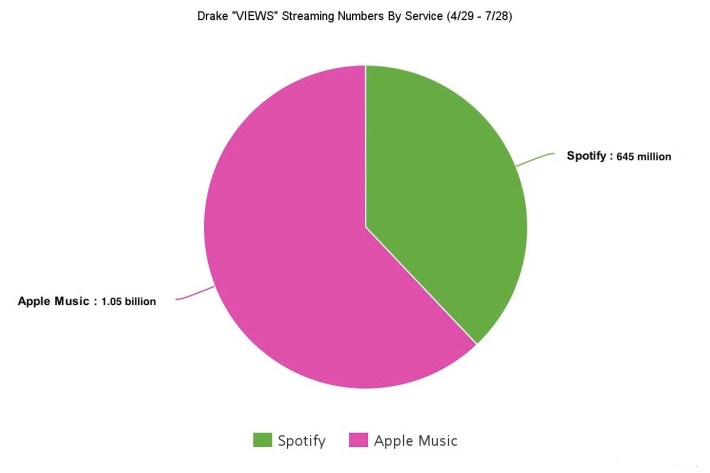
That's a great way to build a cult, but it's a really shitty way to build a fan base, and an absolutely AWFUL approach to artist development. Drake is a legitimate star, but his partnership with Apple Music has actually led to his music reaching a much smaller percentage of his potential audience. Exclusivity is bad for the artist, bad for the audience, and it may not even help the fucking provider. (What's good, Tidal?) For fuck's sake, APPLE MUSIC'S CHURN RATE IS THREE TIMES HIGHER THAN SPOTIFY'S! What's that mean? You tell 'em, Business Insider:
In a note last week, Cowen's John Blackledge and Tim Arcuri wrote that Apple Music's subscriber churn rate of 6.4% per month is almost three times that of Spotify. That means that even though Cowen's survey suggests that Apple Music will add nearly as many paid subscribers as Spotify in the next year, roughly three-quarters of those could quit the service, the analysts write.
Oof. Why's that?
For "exclusives" to stop people from cancelling their Apple Music subscriptions, they have to feel like there isn't significant downtime between one and the other, that there is a steady stream of releases they don't want to miss.
Earlier this week, Music Business Worldwide published a guest post by DJ Skee titled "Why Exclusives Are Terrible For Fans, Artists, And The Streaming Music Business." Here's a pretty good excerpt from that post:
Exclusivity as we know it was a result of a desperate music business struggling in the big-box retail era. Once record stores started going under and outlets like Target and Wal-Mart became the places mainstream consumers bought music, the chains demanded that labels give them something special to entice customers to their doors.
This is exactly what's happening here, too. Drake's a loss leader: a commodity being leveraged to attract customers not to Drake, but to Apple Music. It's hard to say Drake has suffered as a result of this partnership -- my man hasn't really suffered a day in his life, near as I can tell, and he ain't about to start now -- but he's sacrificed the world stage for a niche platform built to enhance the perceived value of a luxury brand aimed at higher-end consumers with middlebrow tastes.
The notion that VIEWS is this year's Purple Rain, or that Drake is "officially" as popular as Michael Jackson was during Thriller, or that Views is already one of the biggest hip-hop albums of all time? That's nonsense. It is empirically, objectively untrue. VIEWS is a rather successful album that happens to have done obscene numbers in a closed-gated community whose total user base comprises less than five fucking percent of the country's population. It's the musical equivalent of a Lexus RX 350. Or a case of LaCroix seltzer. Or a pair of Beats headphones.
Sounds harsh, I know, but it's not like people everywhere are even all that stoked on the fucking album, are they? Critics have been universally unimpressed -- VIEWS currently has a score of Metascore of 69, its average grade based on reviews from 31 critics. But you know who's really apathetic about the thing? FANS. The album has a User Score of 6.0: its average grade based on ratings from 668 regular non-critic folks.
Small sample sizes, I know. I'm just saying: That's your historic album? That's the 2016 Purple Rain from an artist as big as Thriller-era Michael Jackson?
This is where it's at: Outside of Apple Music's 15 million users, Drake is pretty popular. Inside that little gated community though, Drake is fucking royalty. He runs that fiefdom. Inside Apple Music, Drake eats everybody's lunch.
That's not really a figure of speech. You gotta wonder what the focus on Drake means for every other artist whose records are on Apple Music. The company is spending so much money forcing VIEWS on its subscribers that it's kind of hard to see how they're listening to anything else. I mean...
NYC TODAY #VIEWS
Powered by @beatsbydre pic.twitter.com/KGxVm8EnTy— Drizzy (@Drake) April 18, 2016
Can you imagine that sort of conflict of interest in any other semi-regulated industry? I'm frankly not 100-percent sure it's not a violation of US antitrust laws, and I'm astonished that it's been paraded around so flagrantly. You have basically two options for on-demand streaming music ... AND ONE OF THOSE OPTIONS HAS SPENT TENS OF MILLIONS OF DOLLARS PROMOTING ONE FUCKING ALBUM FOR THE LAST THREE FUCKING MONTHS. And not only promoting it, but promoting it so successfully that it has basically run laps around every other album in Apple Music's infinite catalog. All those other albums are in its shadow.
You don't get a billion-plus streams out of 15 million listeners in 13 weeks without a little collateral damage. You can't.
And that's bullshit. Fuck that.
That ends today.
Because today ... VIEWS gets bumped from the #1 chart spot by DJ Khaled's Major Key, another Apple Music exclusive!
Haha. Little joke. It's never going to end. Here's another good line from that DJ Skee thing:
Alas, no one seems to have learned any lessons from [the Life Of Pablo] debacle -- major artists continue to release albums exclusively to a single platform, and I've heard one of the major streaming services has told employees to go all-in on securing exclusive releases.
"One of the major streaming services." HMM WHO COULD IT BE? Remember: There are two major streaming services.
You wanna see how many people are listening to VIEWS? This many:
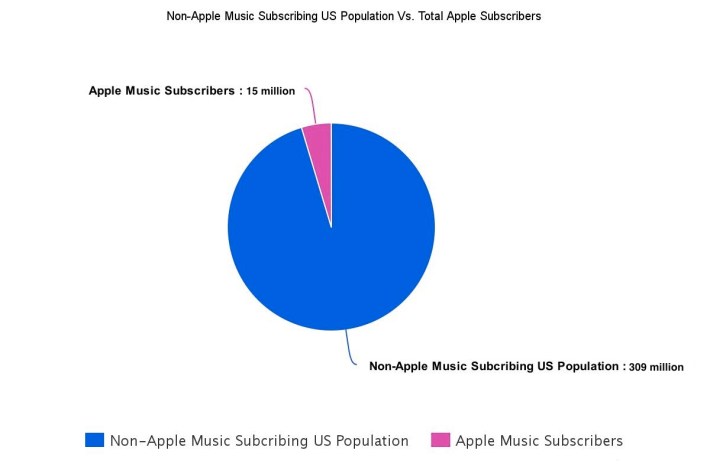
I mean it's not really that many. That's Apple Music's total subscriber base relative to the rest of the US population. It's really way less than that.
Look we're all the way at the bottom of this thing, and everybody else gave up on it at least 1500 words back, so now that it's just us, let's go ahead and explode the fuck out of it, OK?
Apple Music is reportedly available in 113 countries around the world, so it doesn't actually have 15 million subscribers in the US. It has maybe ... 10 million? This assumes it has, on average, 45,000-or-so subscribers in each of those other 112 countries.
So that makes the sliver a little bit smaller. Moving on, look, let's be realistic here, not all 10 million of those people are listening to VIEWS. That's ludicrous. Apple Music isn't actually a Drake fan club; it's the second-biggest on-demand music streaming service in the world, run by the biggest company in the world! There's some demographic diversity among its subscribers. Let's say 5 million US-residing Apple Music subscribers are listening to VIEWS. That seems generous, but I'm in a generous mood.
This is what we're left with:
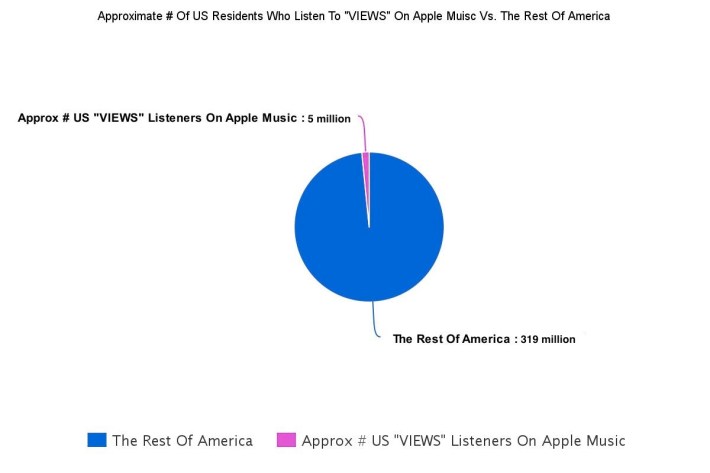
That's your Thriller. That's your Purple Rain. That's more than one billion streams in 13 weeks. That, right there.
You can barely even see the tiny little fella!
The most remarkable thing about VIEWS is not how many people are listening to VIEWS.
The most remarkable thing is how few people are listening, or even paying any attention at all.

